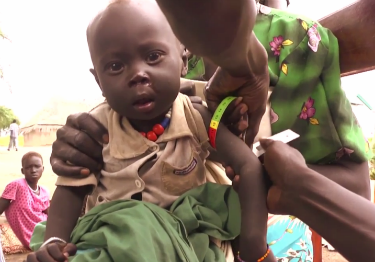By Mike Pflanz*, (UNICEF) – As a food crisis threatens millions in conflict-stricken South Sudan, families are eating whatever they can to survive. Without more urgent international help, many will likely die of starvation.*
KIECH KUON, South Sudan, 25 August 2014 – In the field next to Nyakaka Wal’s home in rural South Sudan, maize plants stand tall and dense, an acre or more of desperately needed food slowly growing in the hot sun.
But it is ripening too slowly for Nyakaka and her children. Harvest is still six weeks away, at least, and she and her family are struggling on the fringes of survival, eating only wild plants plucked from the ground, or dry-roasted cow’s blood.
An estimated 3.9 million people are facing emergency levels of food insecurity in South Sudan, where conflict that broke out at the end of 2013 forced people to flee their homes and fields. As a result, planting was delayed, and food stockpiles kept for lean times were looted.
“There is nothing for us to eat – nothing,” Nyakaka says, pushing open the wooden door to her mud-walled home to show the bare spot where usually sacks of sorghum or maize would be stored.
“To get anything, I have to walk three days to the nearest market where I can sell maybe a goat or a cow,” she says. “We have some animals, but selling them is terrible, because the price is so bad now. But we have no choice.”
Still, even the desperate measure of selling livestock – the equivalent of emptying the savings account – is not enough.
Morning and evening, Nyakaka and her 8-year-old daughter, Nyaboth, join their neighbours pulling up handfuls of a small-leaved succulent plant known in the local Nuer language as ‘woor’, which grows wild close to the ground all around Nyakaka’s village.
The plant is slowly simmered in water for more than an hour and then cooled, leaving a bitter green sludge that is all Nyakaka can offer Nyaboth as the family meal each day. To go with it: small, hard pellets of dried cow’s blood that look like tiny gravel stones and taste metallic and sour.
Serious crisis
In other parts of the three South Sudanese states worst affected by the recent fighting – Upper Nile, where Nyakaka lives, Unity and Jonglei – other families survive only on the milk of their cows, or on fish caught in the swamps, or on the leaves of water lilies that float there.
 © UNICEF Video | A woman in Kiech Kuon collects grasses to feed her family. © UNICEF Video | A woman in Kiech Kuon collects grasses to feed her family.
|
None of these things provides anywhere close to the amount of nutrients or energy that a child or pregnant or breastfeeding mother needs, says Angela Kangori, a UNICEF nutrition specialist who was recently in Kiech Kuon.
“There is a serious malnutrition crisis in many parts of the country, and you can see why when you realize what people, children especially, are having to eat,” she says.
Many people living in the worst-affected areas have already fallen into the desperate situation officially calculated as that which immediately precedes a famine, Phase 4 of the Integrated Phase Classification, the standard global measure for food insecurity.
“We can only pray”
Whether these areas will continue the slide into Phase 5 – famine – now depends on whether enough emergency food aid can reach them in time. Currently, the combined United Nations and international aid agencies emergency appeal for South Sudan is only 51 per cent funded.
Without more financial assistance coming quickly, Nyakaka and millions of people like her face a potentially deadly few weeks before they can harvest their crops. Even after that, the situation has become so dangerous that help is likely to be needed well into 2015.
“There was another time that we had to eat these grasses, a long time ago when I was a child like my daughter is now,” says Nyakaka, who is 23. “But even that was not bad like things are now. This is the worst that I have seen, and even the old ladies tell us that it is the worst that they have seen too. We can only pray the hard times pass soon.”
*Source: UNICEF. Go to Original.
Read also:
South Sudan: Water Shortages Hit Crisis Point in Refugee Camps
Dramatic Situation of Over 100,000 Refugees in South Sudan
‘Alarming’ Health Situation in South Sudan Camps
Manhunt: This is Racism, Pure and Simple
S. Sudan Returnees Complain of ‘Harsh Treatment’ in Israel – UN
South Sudan: Yet Another Kitchen-Garden?
South Sudan the Year After – Violence and Misery Everywhere
South Sudan: “People are Dying, People are Suffering—This Is a Crisis”
No Food for Half of Oil-Rich South Sudan Population
Does Anyone Know Anything About A New Country Called South Sudan?
South Sudan’s Population: Rural, Poor And Uneducated
Sudan – South Sudan: Oil and the Dragon
A ‘Storm of Hunger’ Gathering on South Sudan










